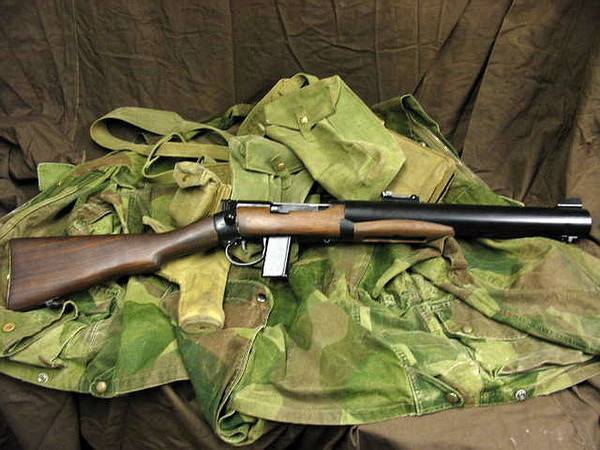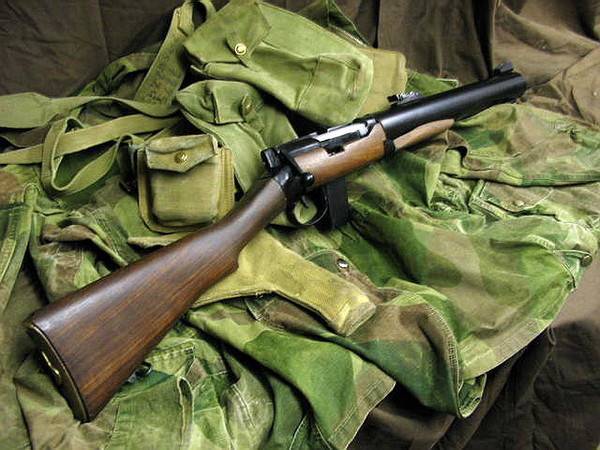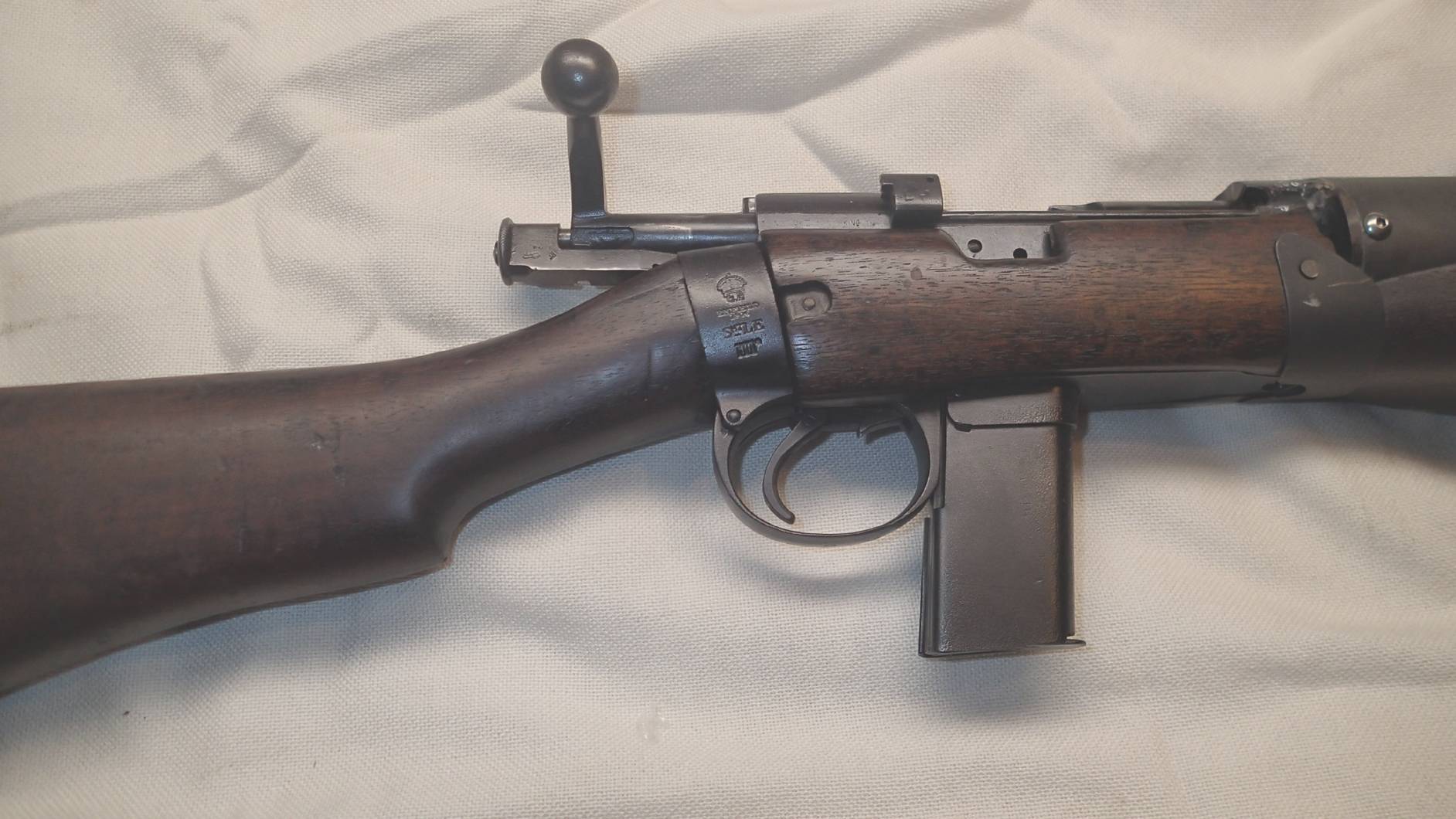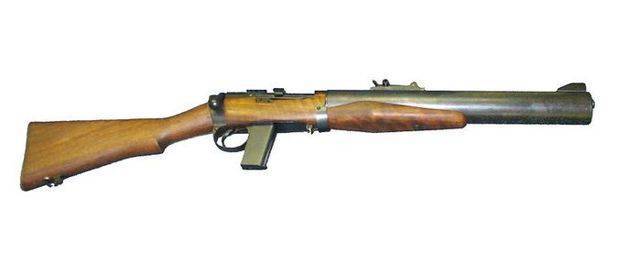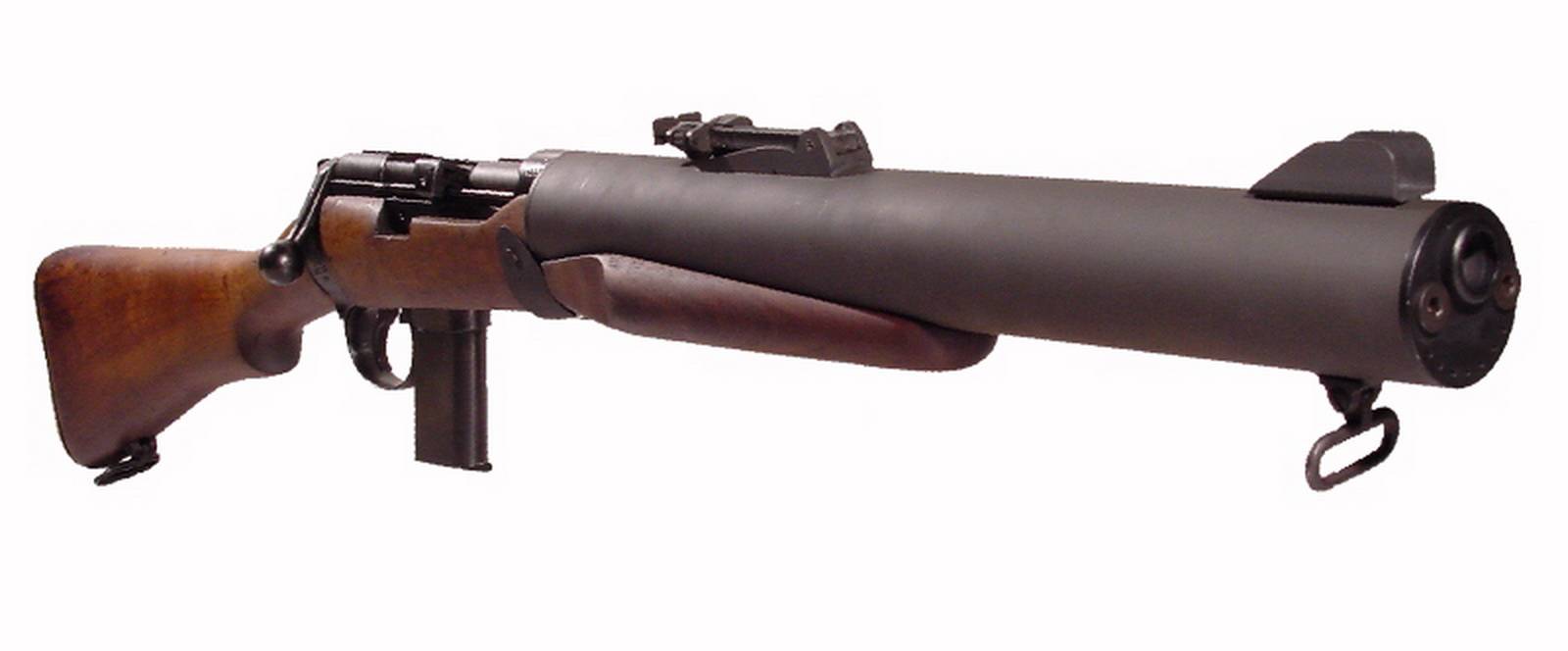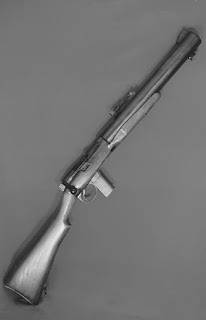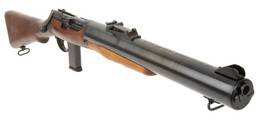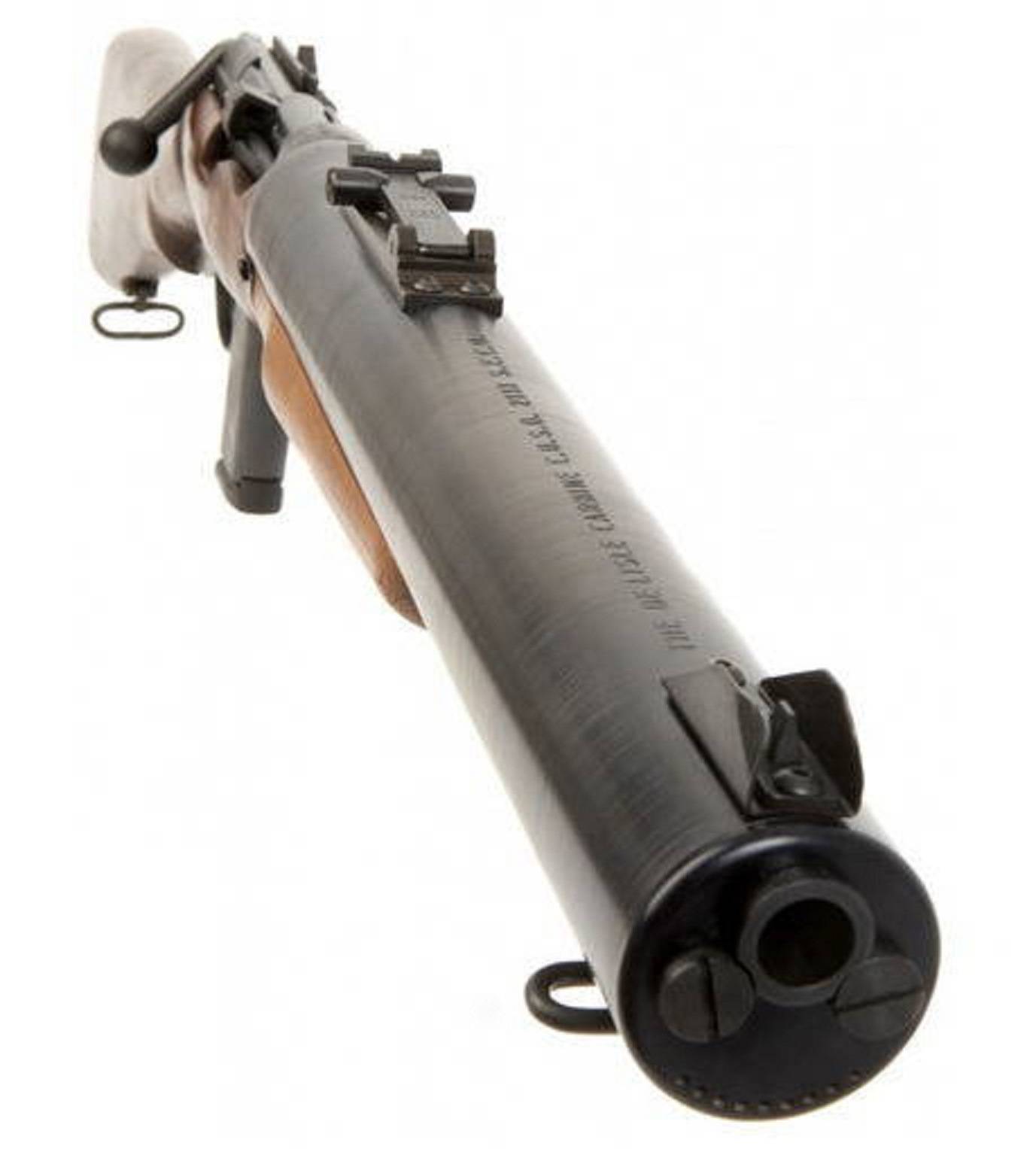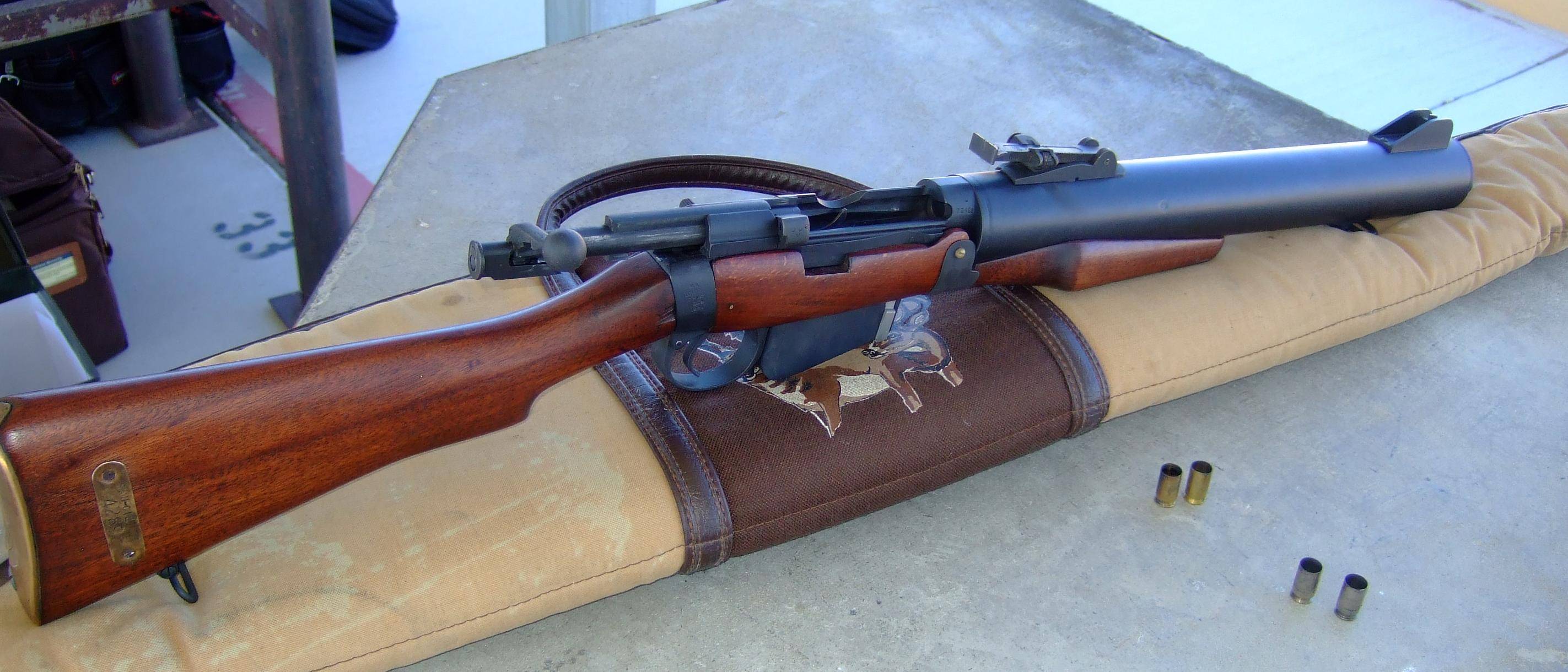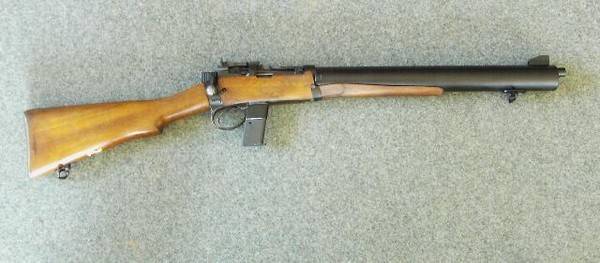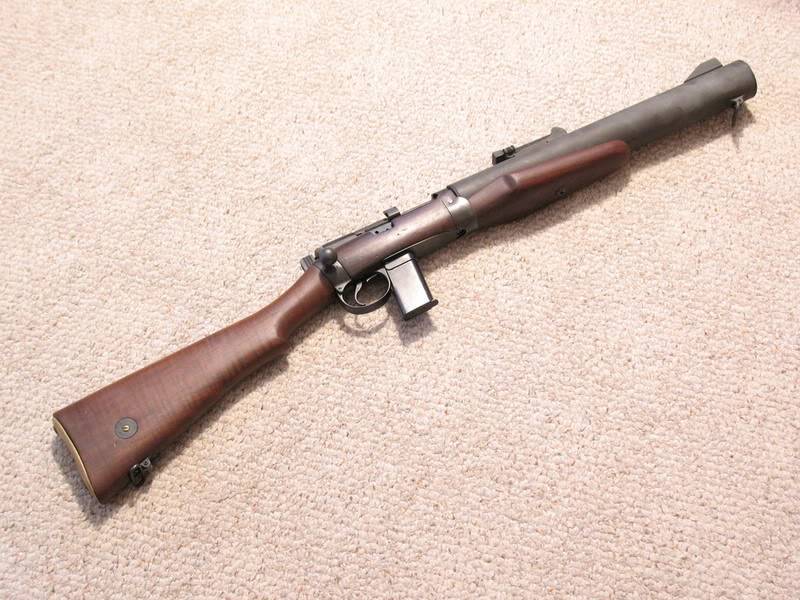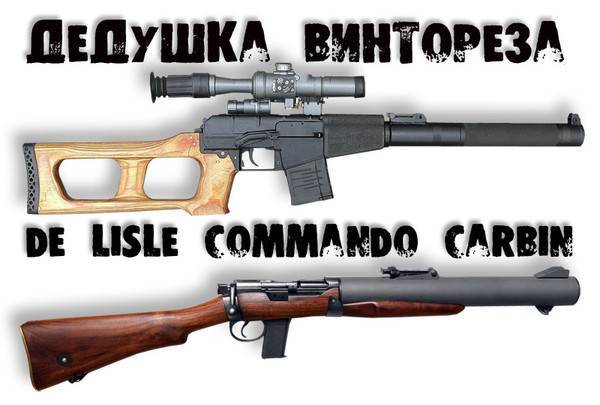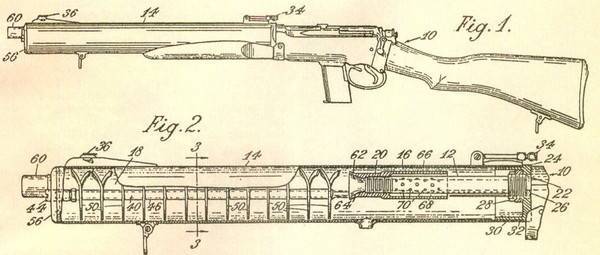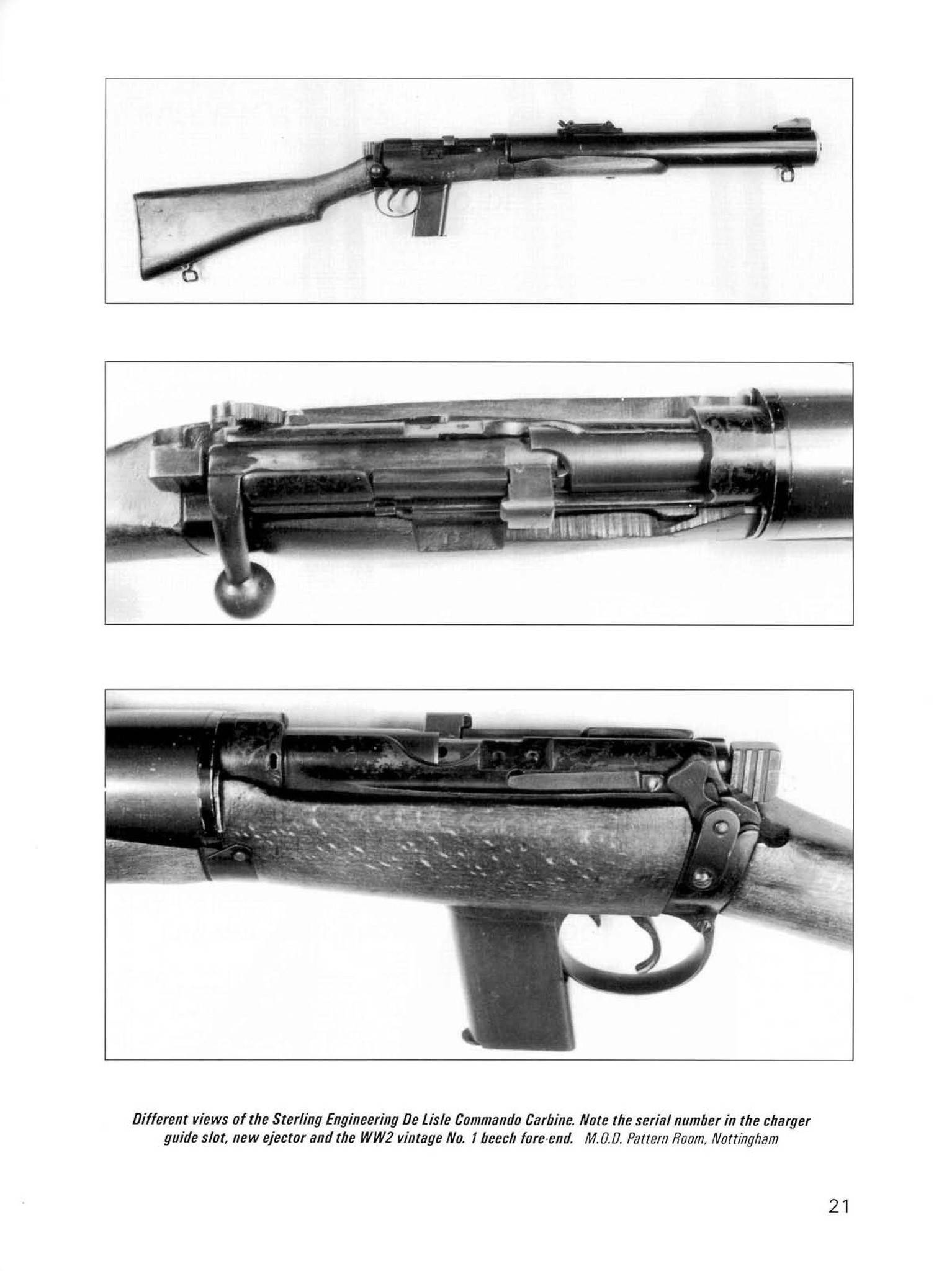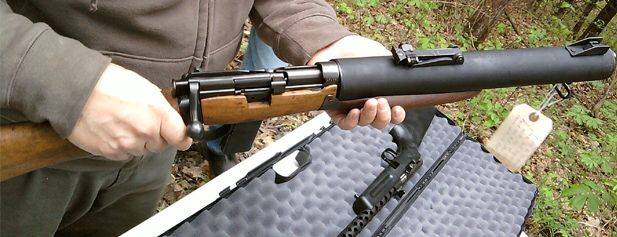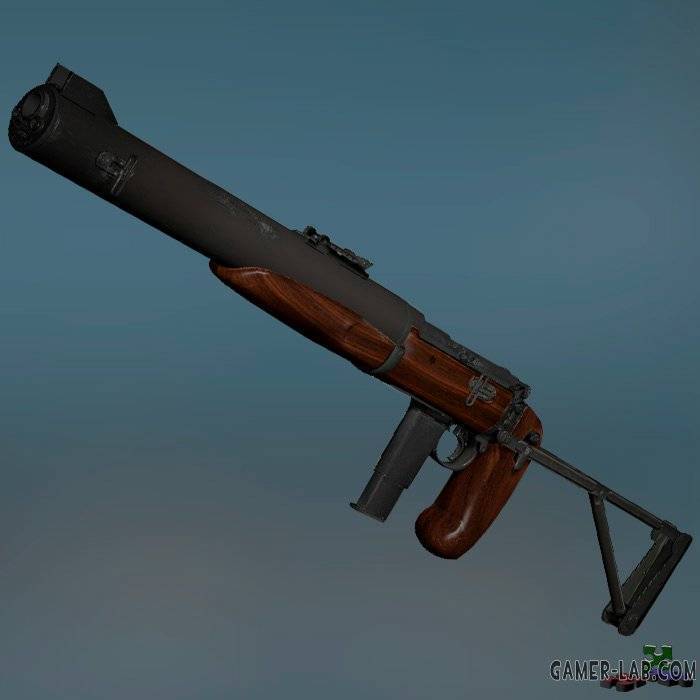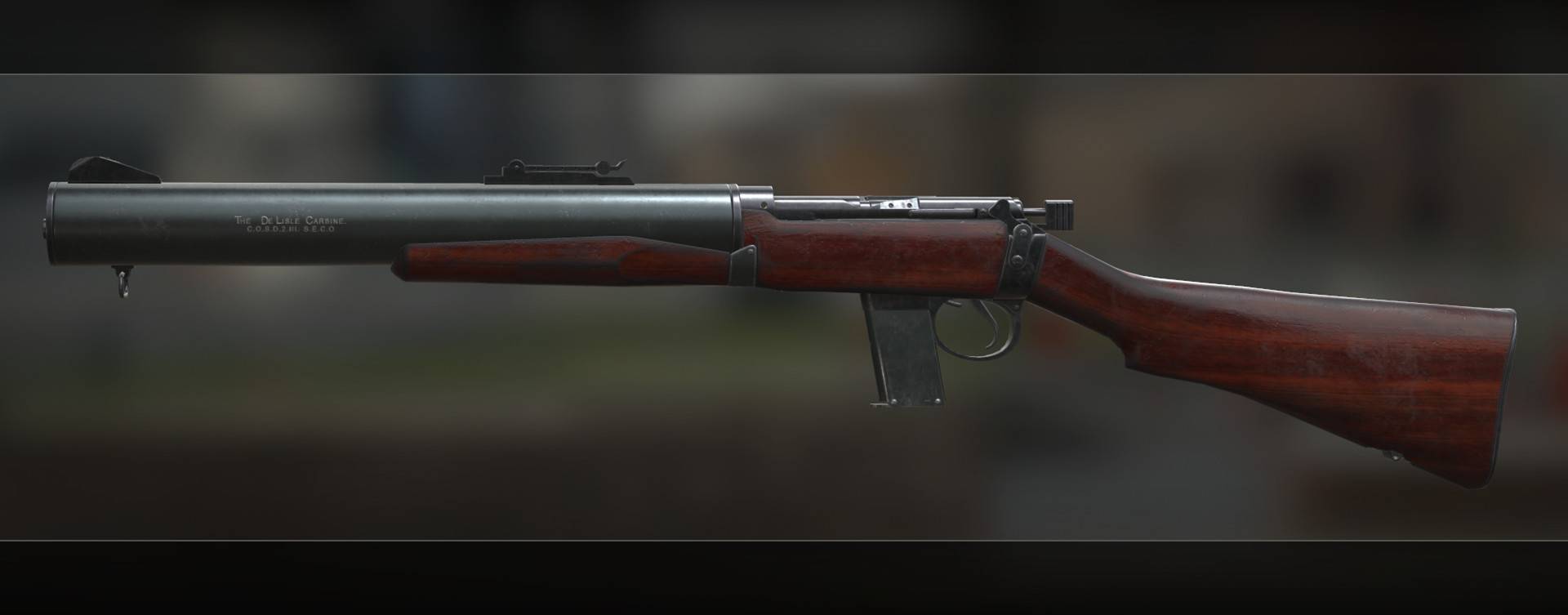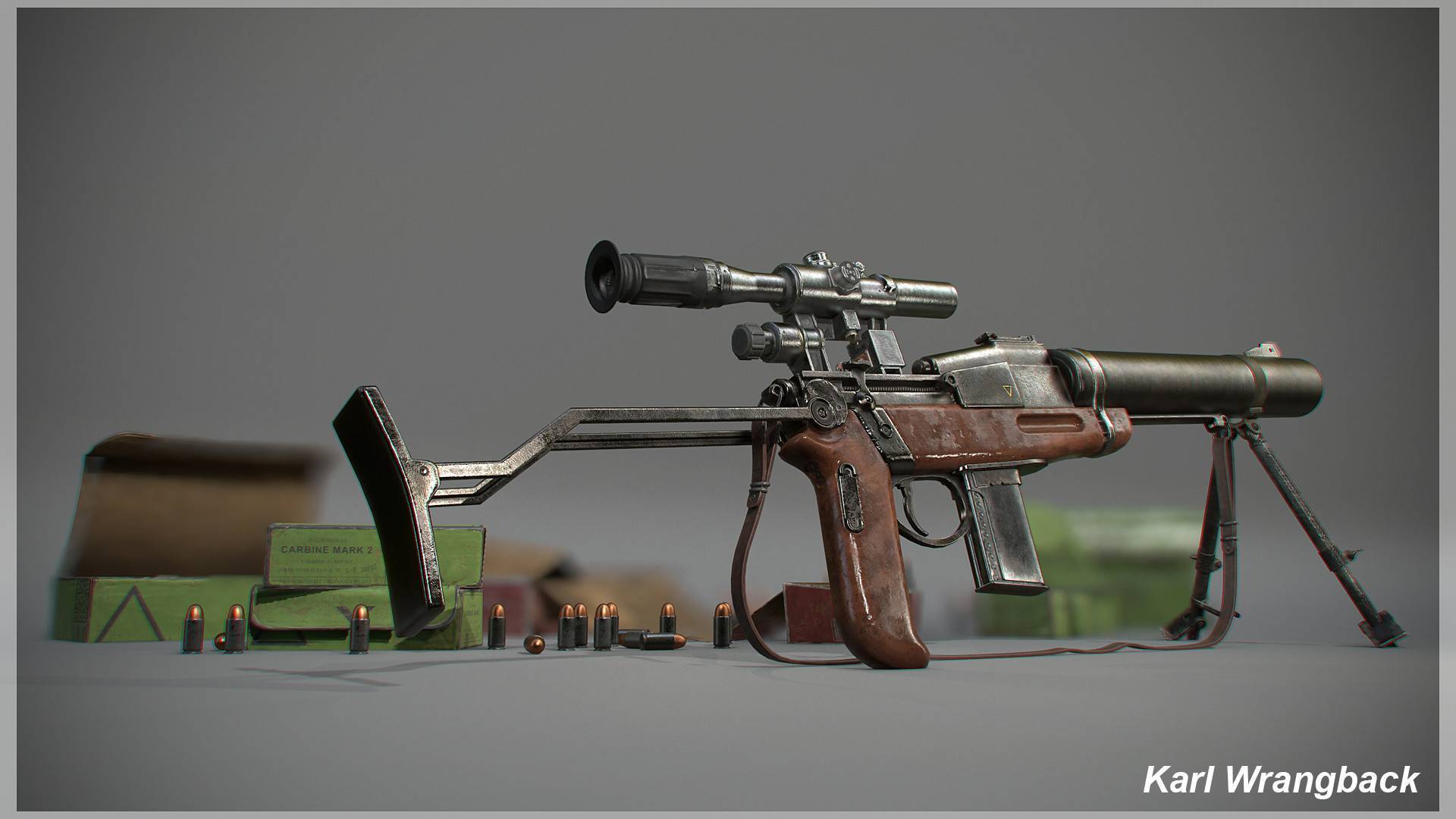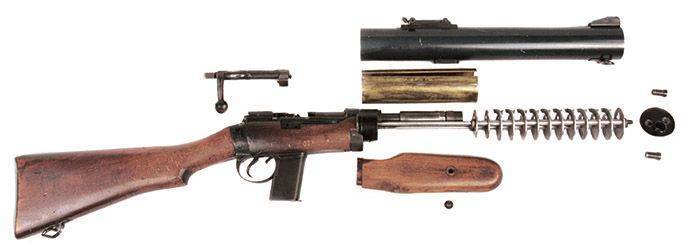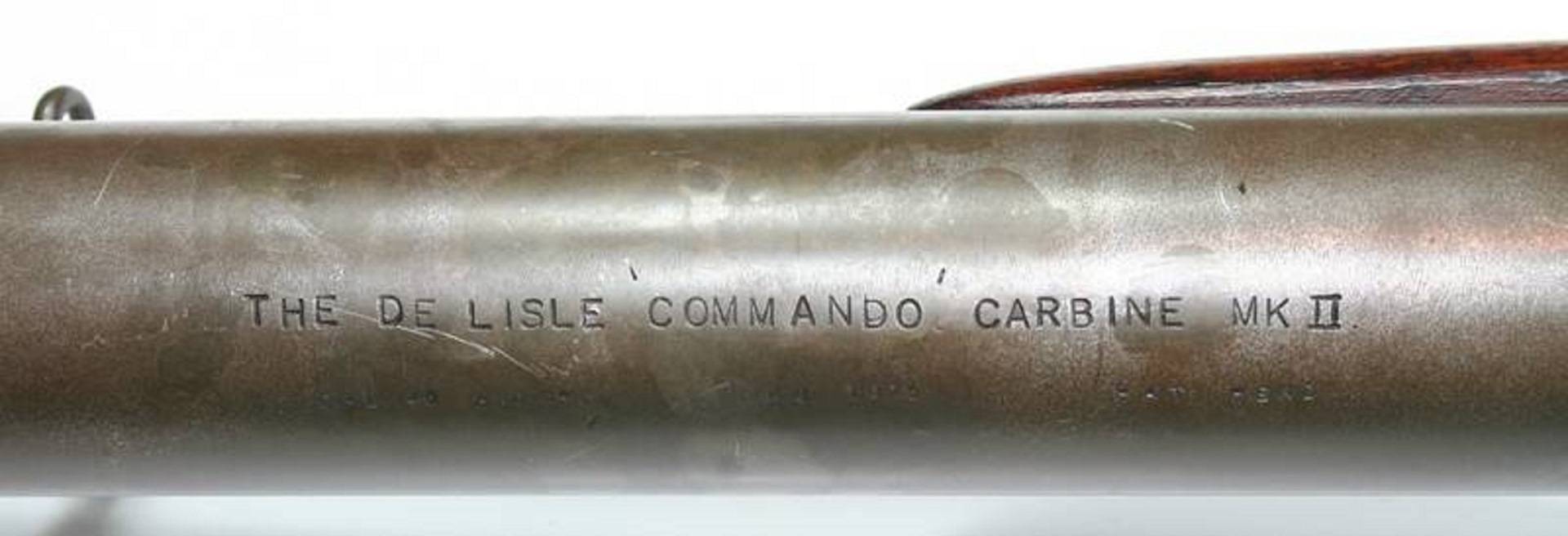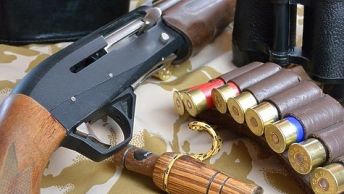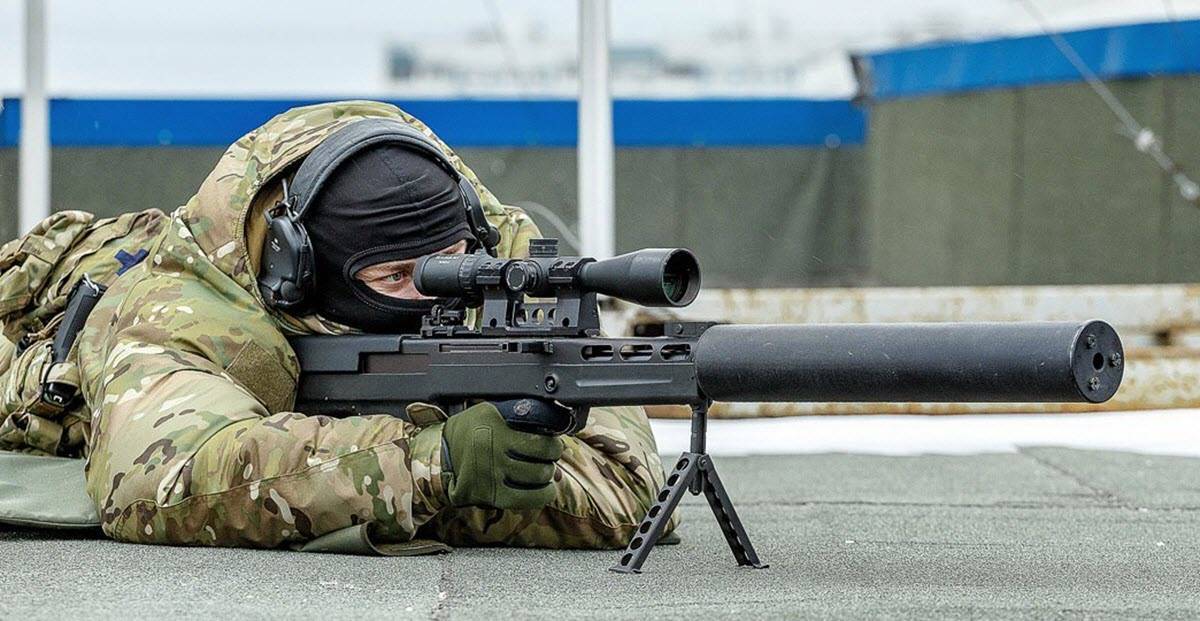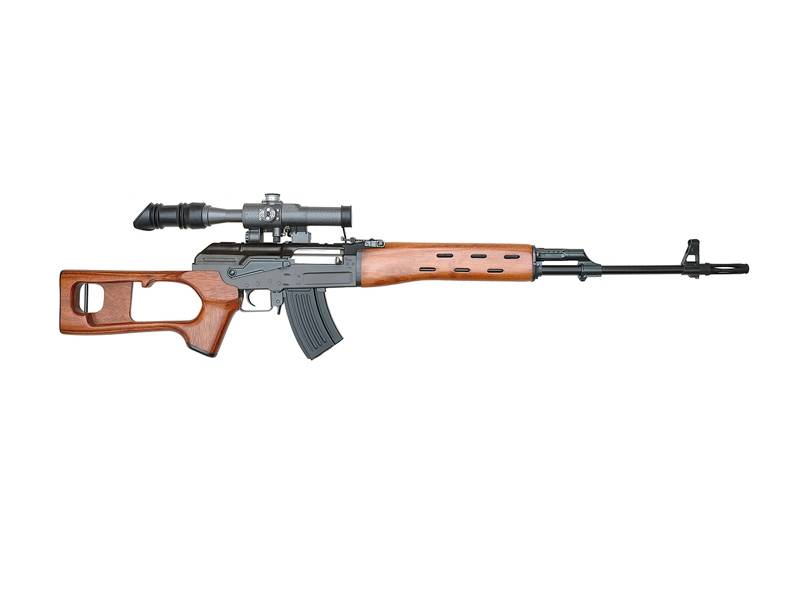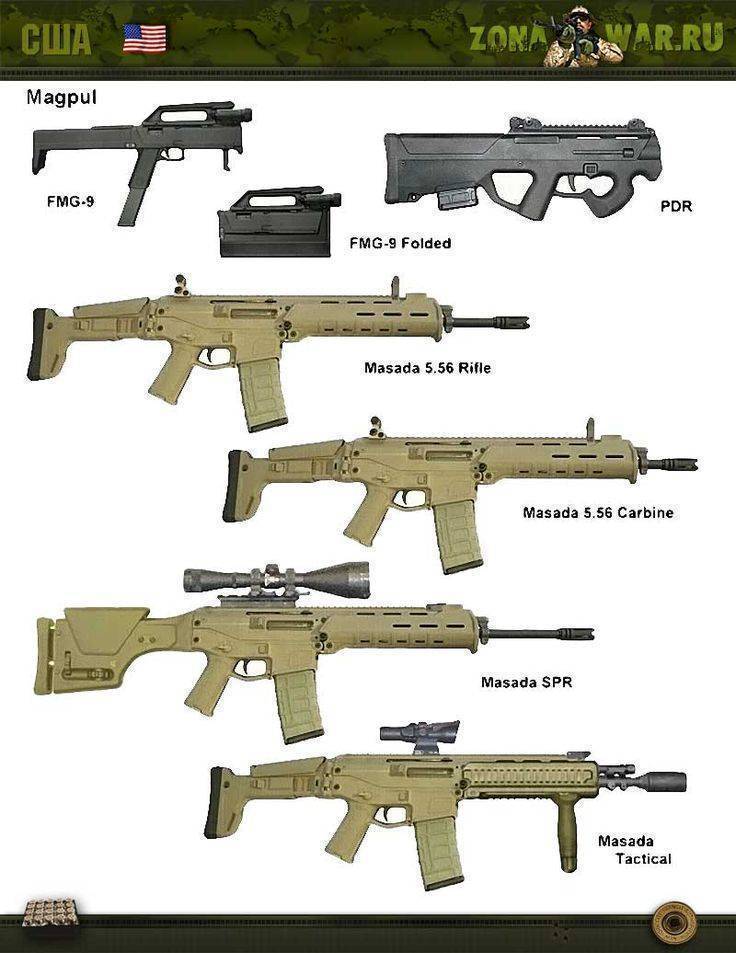See also
- —there were suppressed versions of the Sten, also used to kill people silently.
- Welrod pistol
The De Lisle Silenced ”Commando”Carbine & Welrod Pistol
- ^
- ^ Rome, p.28
- Special Service Lee Enfields: Commando and Auto Models by Ian Skennerton, Australia, 2001. ISBN 0-949749-37-0
- Rome, p.31
- ^ Rome, p.27
- ^ Rome, p.29
- ^
- Rome, p.30
- ^ Rome, p.32
- Hogg, Ian; John Weeks (1977). Military Small Arms of the 20th Century. Arms & Armour Press. p. 128. ISBN 978-0-85368-301-8.
- Bishop, Chris (2002). The Encyclopedia of Weapons of World War II. Sterling Publishing Company, Inc. pp. 220–221. ISBN 978-1-58663-762-0.
- Dockery, Kevin (2007). Stalkers and Shooters: A History of Snipers. BERKLEY Publishing Group. pp. 226–227. ISBN 978-0-425-21542-5.
история
Оружие было разработано как частное предприятие Уильяма Godfray де Лиль (известный как Godfray), инженер , который работал для министерства авиации . Он сделал первый прототип в .22 калибра ; это он испытал, стреляя кроликов и другую мелкую дичь за столом, возле своего дома на Беркшир Даунс . В 1943 году он подошел майор сэр Малькольм Кэмпбелл из общевойсковых операций с его прототипом; это неформально испытание при стрельбе оружия в Темзу с крыши здания Нового Аделого в Лондоне. Это было выбрано , чтобы обнаружить , если люди на улице ниже слышали стрельбу – они не делали. Комбинированные операции должностных лица были впечатленный с оружием и просили Делиль производить 9ммы версии. Тем не менее, это был провал. Третий прототип, используя ACP .45 патрон , который был излюбленный де Лиль, был гораздо более успешным. Испытания показали , это оружие было приемлемая точность, не дало никакой видимой вспышки и не было слышен на расстоянии 50 ярдов (46 м).
Последующие официальные огневые испытания регистрировали Делиль произвел 85,5 дБ шума при выстреле. Для сравнения, современные испытания на выборе ручного огнестрельного оружия показал , что они производят 156 до 168 дБ при стрельбе без глушителя, и 117 до 140 дБ при стрельбе с одной установленной. Бесшумность В Делиль был найден сопоставимым с британской Welrod пистолета. Однако Welrod был полезен только при очень близком расстоянии и используются тканевые и резиновые компоненты в супрессоров , которые требуют замены после нескольких выстрелов. Де Лиль был в состоянии стрелять сотни раундов , прежде чем супрессоры требуются разборки для очистки.
Combined Operations просил небольшой производственный цикл де Лиль карабинов и первая партия из 17 были вручную сделаны Форд Dagenham , с самим Godfray Де Лиль освобожден от своих обязанностей министерство авиации , чтобы он мог работать полный рабочий день по проекту; это первая партия была немедленно введена в боевое применение со стороны британских коммандос . В 1944 году Sterling Вооружение компании был дан заказ на 500 Делиль карабинов, но в конечном счете производится только около 130. Версия Sterling отличающуюся в ряде деталей из ранее, модели Форд Dagenham. Два прототипа другого варианта, для сил ВДВ , были сделаны. Они были откидные акции, аналогичные тем , которые установлены на Sterling пистолет – пулемет .
В течение оставшейся части Второй мировой войны, карабин Делиль был в основном используется коммандос, хотя они также видели некоторое использование со стороны специальных операций (SOE). E. Майкл Берк , американский бывший командир Jedburgh команды заявил , что Делиль был использован ими убить двух старших немецких офицеров в 1944 году.
Ряд De Lisles были отправлены на Дальний Восток и используется во время кампании в Бирме . Делиль также будет использоваться во время корейской войны и Малайского Emergency . Утверждалось , оружие также используется специальной службы воздуха во время Северной Ирландии Смутного .
De Lisle carbine
De Lisle Commando Carbine De Lisle Carbine. Top, with wooden stock. Bottom, with folding stock from a Patchett submachine gunTypeCarbinePlace of originUnited KingdomService historyIn service1943–1965Used byUnited KingdomWarsWorld War II, Korean War, Malayan EmergencyProduction historyDesignerWilliam G. De LisleDesigned1942ManufacturerFord Dagenham (17 prototypes) Sterling Armaments CompanyProduced1942–1945No. built129VariantsFord Dagenham Prototypes Folding stock Parachute Carbine, only one example producedSpecificationsMass7 lb 8 oz (3.74 kg), unloaded Length35.3 in Barrel length8.27 in (210 mm) Cartridge.45 ACP (11.43×23mm)Calibre.45ActionBolt actionRate of fire20–30 rounds/minuteMuzzle velocityabout 830 ft/s (250 m/s)Effective firing range200 yd (185 m)Maximum firing range400 yd (365 m)Feed system7 or 11-round detachable magazineSightsFord Dagenham: Winchester rifle sight at rear, simple ramp with modified P-14 front sight protector at front. Sterling models: Lanchester Mk I rear sight (later changed to Lanchester Mk I*), windage adjustable front sight. Airborne model: Lanchester Mk I rear sight, windage adjustable front sight
The De Lisle carbine or De Lisle Commando carbine was a British firearm used during World War II that was designed with an integrated suppressor. That, combined with its use of subsonic ammunition, made it extremely quiet in action, possibly one of the quietest firearms ever made.
Few were manufactured as their use was limited to specialist military units.
History
The weapon was designed as a private venture by William Godfray de Lisle (known as Godfray), an engineer who worked for the Air Ministry. He made the first prototype in .22 calibre; this he tested by shooting rabbits and other small game for the table, near his home on the Berkshire Downs.
In 1943, he approached Major Sir Malcolm Campbell of Combined Operations with his prototype; this was informally tested by firing the weapon into the River Thames from the roof of the New Adelphi building in London. This was chosen to discover if people in the street below heard it firing – they did not.
Combined Operations officials were impressed with the weapon and requested De Lisle produce a 9mm version. However, this was a failure. A third prototype, using the .45 ACP cartridge that was favoured by de Lisle, was much more successful.
Tests of this showed the weapon had acceptable accuracy, produced no visible muzzle flash and was inaudible at a distance of 50 yards (46 m).
Subsequent official firing tests recorded the De Lisle produced 85.5 dB of noise when fired. As a comparison, modern testing on a selection of handguns has shown that they produce 156 to 168 dB when firing without a suppressor, and 117 to 140 dB when firing with one fitted.
The de Lisle’s quietness was found to be comparable to the British Welrod pistol. However, the Welrod was useful only at very short range and used fabric and rubber components in the suppressor that required replacement after a few shots.
The de Lisle was able to fire hundreds of rounds before the suppressor required disassembly for cleaning.
Combined Operations requested a small production run of De Lisle carbines and an initial batch of 17 were hand–made by Ford Dagenham, with Godfray De Lisle himself released from his Air Ministry duties so he could work full-time on the project; this initial batch was immediately put into combat use by the British Commandos.
In 1944, the Sterling Armaments Company was given an order for 500 De Lisle carbines, but eventually only produced around 130. The Sterling version differed in a number of details from the earlier, Ford Dagenham model. Two prototypes of a further version, for Airborne forces, were made.
These had folding stocks, similar to those fitted to the Sterling submachine gun.
A number of De Lisles were shipped to the Far East and used during the Burma Campaign. The De Lisle would also be used during the Korean War and the Malayan Emergency. It has been claimed the weapon was also used by the Special Air Service during the Northern Irish Troubles.
Описание
Первоначальный wooden- укомплектованного De Лиля с оборудованным глушителем
Де Лиль был основан на преобразуется в .45 ACP путем модификации приемника , изменяя болт / bolthead, заменив бочку с модифицированной Пистолет – пулемет Томпсона ствола (6 канавки, RH завихрение), и с использованием модифицированных журналов из пистолета M1911 . Основная особенность Де Лиль была его чрезвычайно эффективные супрессорами , который сделал это очень тихо в действии. Так тихо , что работая болт (к камере следующий раунд), делает более громкий шум , чем стрельба картридж.
.45 АСР патрон был выбран в качестве его дульная скорость дозвуковая для типичных длин ствола. Таким образом , было бы как сохранить свою полную летальность и не требуют специальных нагруженных боеприпасов для использования с глушителем. Большинство стрелковых патронов сверхзвуковые, где пуля генерирует « звуковой удар » , как и любой другой объект , движущегося со сверхзвуковой скоростью, что делает их непригодными для тайных целей. Ствол пистолета Томпсон был перенесен (т.е. с просверленными отверстиями) , чтобы обеспечить контролируемое высвобождение газа высокого давления в супрессора , который окружает его , прежде чем пуля покидает ствол. Супрессоры, 2 дюйма (5,1 см) в диаметре, прошли весь путь от задней части ствола к хорошо за пределами морды , что составляет половину общей длины оружия. Супрессоров при условии , очень большой объем , чтобы содержать газы , полученные путем обжига; это один из ключей к его эффективности. MP5SD и AS Val среди другого современного огнестрельного оружия , которые используют ту же концепцию.
Болт Lee-Enfield был сокращен кормить .45 ACP раундов; на Ли-Энфилд журналом установка была заменена на новую сборку , которая провела модифицированный журнал M1911. Операция болта предложила преимущество в том , что стрелок может воздержаться от досылание следующего раунда , если абсолютная тишина требуется после обжига. Полуавтоматическое оружие не предложил бы этот вариант как езда на велосипеде болта в сочетании с побега назад пропеллент и звон пустого дела в отношении какой – либо твердой поверхности будет производить шум с каждым выстрелом. Как тихо , как карабин был, это было не очень точным.
Собственный +0,22 прототип де Лиль был дан в Национальном музее армии в Лондоне, но впоследствии она была потеряна и ее нынешнее местонахождение неизвестно. Репродукция +0,45 калибра карабина производится американской компанией, Валькирия оружием. Еще одна компании, Special Interest Arms, объявила ограниченное производство реплики De Лили , которая включает в себя улучшенную систему адаптера журнала , который позволяет использовать немодифицированные M1911 журналы , а также полностью поддерживает патронник в действии.
History
The weapon was designed as a private venture by William Godfray de Lisle (known as Godfray), an engineer who worked for the Air Ministry. He made the first prototype in .22 calibre; this he tested by shooting rabbits and other small game for the table, near his home on the Berkshire Downs. In 1943, he approached Major Sir Malcolm Campbell of Combined Operations with his prototype; this was informally tested by firing the weapon into the River Thames from the roof of the New Adelphi building in London. This was chosen to discover if people in the street below heard it firing – they did not. Combined Operations officials were impressed with the weapon and requested De Lisle produce a 9mm version. However, this was a failure. A third prototype, using the .45 ACP cartridge that was favoured by de Lisle, was much more successful. Tests of this showed the weapon had acceptable accuracy, produced no visible muzzle flash and was inaudible at a distance of 50 yards (46 m).
Subsequent official firing tests recorded the De Lisle produced 85.5 dB of noise when fired. As a comparison, modern testing on a selection of handguns has shown that they produce 156 to 168 dB when firing without a suppressor, and 117 to 140 dB when firing with one fitted. The De Lisle’s quietness was found to be comparable to the British Welrod pistol. However, the Welrod was useful only at very short range and used fabric and rubber components in the suppressor that required replacement after a few shots. The De Lisle was able to fire hundreds of rounds before the suppressor required disassembly for cleaning.
Combined Operations requested a small production run of De Lisle carbines and an initial batch of 17 were hand–made by Ford Dagenham, with Godfray De Lisle himself released from his Air Ministry duties so he could work full-time on the project; this initial batch was immediately put into combat use by the British Commandos. In 1944, the Sterling Armaments Company was given an order for 500 De Lisle carbines, but eventually only produced around 130. The Sterling version differed in a number of details from the earlier, Ford Dagenham model. Two prototypes of a further version, for Airborne forces, were made. These had folding stocks, similar to those fitted to the Sterling submachine gun.
During the remainder of World War II, the De Lisle carbine was mainly used by the Commandos, although they also saw some use by the Special Operations Executive (SOE).E. Michael Burke, the American former commander of a Jedburgh Team, stated that a De Lisle was used by them to assassinate two senior German officers in 1944.
A number of De Lisles were shipped to the Far East and used during the Burma Campaign. The De Lisle would also be used during the Korean War and the Malayan Emergency. It has been claimed the weapon was also used by the Special Air Service during the Northern Irish Troubles.
Description
The initial wooden-stocked De Lisle with a fitted suppressor
The De Lisle was based on a converted to .45 ACP by modifying the receiver, altering the bolt/bolthead, replacing the barrel with a modified Thompson submachine gun barrel (6 grooves, RH twist), and using modified magazines from the M1911 pistol. The primary feature of the De Lisle was its extremely effective suppressor, which made it very quiet in action. So quiet that working the bolt (to chamber the next round), makes a louder noise than firing a cartridge.
The .45 ACP cartridge was selected as its muzzle velocity is subsonic for typical barrel lengths; consequently it would both retain its full lethality and not require custom-loaded ammunition to use with a suppressor. Most rifle rounds are supersonic, where the bullet generates a “sonic boom” like any other object traveling at supersonic velocities, making them unsuitable for covert purposes. The Thompson gun barrel was ported (i.e. drilled with holes) to provide a controlled release of high pressure gas into the suppressor that surrounds it before the bullet leaves the barrel. The suppressor, 2 inches (5.1 cm) in diameter, went all the way from the back of the barrel to well beyond the muzzle, making up half the overall length of the weapon. The suppressor provided a very large volume to contain the gases produced by firing; this was one of the keys to its effectiveness. The MP5SD and AS Val are among other modern firearms that use the same concept.
The Lee–Enfield bolt was shortened to feed the .45 ACP rounds; the Lee–Enfield’s magazine set-up was replaced with a new assembly that held a modified M1911 magazine. The bolt operation offered an advantage in that the shooter could refrain from chambering the next round if absolute silence was required after firing; a semi-automatic weapon would not have offered this option as the cycling of the bolt coupled with rearward escaping propellant gas and the clink of the empty case against any hard surface would produce a noise with each shot. While the carbine was silent, it was not very accurate.
De Lisle’s own .22 prototype was given to the National Army Museum in London, but it was subsequently lost and its present whereabouts are unknown. A reproduction of the .45 calibre carbine is manufactured by the American company Valkyrie Arms. Special Interest Arms for a time produced limited quantities of a De Lisle replica which incorporated an improved magazine adapter system that allows the use of unmodified M1911 magazines and also fully supports the barrel chamber in the action, later discontinued.


